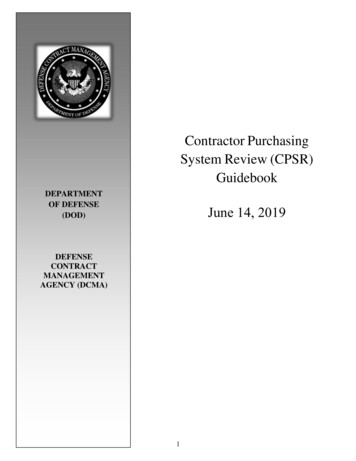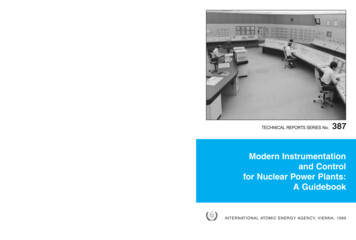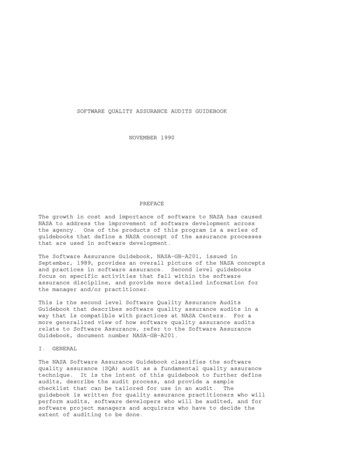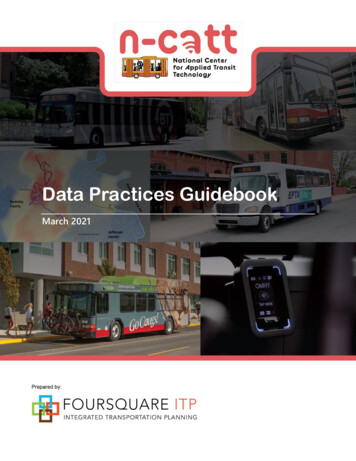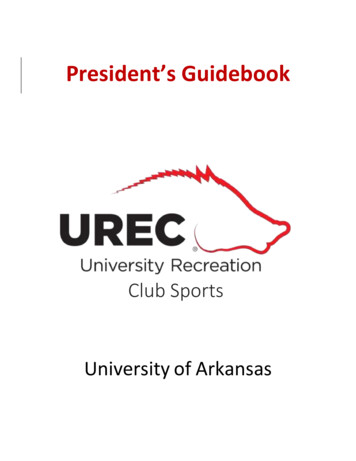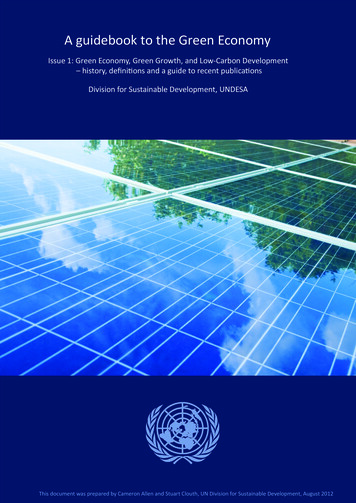
Transcription
A guidebook to the Green EconomyIssue 1: Green Economy, Green Growth, and Low-Carbon Development– history, definitions and a guide to recent publicationsDivision for Sustainable Development, UNDESAThis document was prepared by Cameron Allen and Stuart Clouth, UN Division for Sustainable Development, August 2012
Contents1.Introduction.52.Related concepts: Green economy, green growth and low‐carbon development.63.Green Economy.73.A. Publications. 9Towards a Green Economy: Pathways to Sustainable Development and Poverty Eradication – UNEP. 9Working Towards a Balanced and Inclusive Green Economy – Environmental Management Group, UnitedNations . 10Green Economy Briefing Papers ‐ UNEP. 11Why a Green Economy Matters for the Least Developed Countries ‐UNEP, UNCTAD, UN‐OHRLLS. 11Measuring Progress Towards a Green Economy ‐ UNEP. 12Green Jobs: Towards Decent Work in a Sustainable, Low‐Carbon World ‐ UNEP, ILO . 12Green Economy in a Blue World: Synthesis Report – UNEP, FAO, IMO, UNDP, UNDESA, IUCN, WorldFishCenter, GRID‐Arendal . 13Forests in a Green Economy – A Synthesis, UNEP . 13Green Economy and Trade Opportunities, UNEP . 13Adapting for a Green Economy: Companies, Communities and Climate Change – WRI, Oxfam, UNEP . 14The Transition to a Green Economy: Benefits, Challenges and Risks from a Sustainable DevelopmentPerspective . 15Building an Equitable Green Economy – Danish 92 Group. 16The Road to Rio 20: For a development‐led green economy – UNCTAD. 17Beyond Rio 20: Governance for a Green Economy – Boston University. 17Rio 20 Policy Brief: A green economy for a planet under pressure . 18The Green Economy: Trade and Sustainable Development Implications – UNCTAD . 18A fresh look at the green economy – Oxfam America . 20From Green Economies to Green Societies – UNESCO . 20The future we want, Outcome of the UNCSD 2012 (Rio 20). 21Progress to date and remaining gaps in the implementation of the outcomes of the major summits in thearea of sustainable development, as well as an analysis of the themes of the Conference, UNDESA . 21Secretary‐General’s Report on Objectives and Themes of the UN Conference on Sustainable Development,UNDESA. 22A Green Economy Knowledge‐Sharing Platform: Exploring Options. 23A Global Green New Deal, Edward Barbier . 23A Guidebook for IUCN’s Thematic Programme Area on Greening the World Economy. 24Principles for the Green Economy – Stakeholder Forum . 24
United Nations1. A guide to the green economyThe Principles of a Green, Fair and Inclusive Economy – Green Economy Coalition . 25The Green Economy Pocketbook – Green Economy Coalition . 25International Chamber of Commerce ‐ Green Economy Roadmap and Ten Conditions for a Transitiontoward a Green Economy . 263.B. National Strategies . 26Green Economy: Scoping Study Synthesis Report Barbados – UNEP, UWI, Government of Barbados . 26Green Economy Accord – South Africa . 27Ethiopia’s Climate‐Resilient Green Economy – Federal Democratic Republic of Ethiopia. 28Enabling the Transition to a Green Economy: Government and business working together – HMGovernment, UK . 28Towards a Green Economy in Jordan – UNEP . 29Environments of the Poor in the context of Climate Change and the Green Economy – Government ofNepal . 29National Sustainable Development Strategy: Towards a Green & Fair Economy – Republic Francaise . 30Road Map on Building a Green Economy for Sustainable Development in Carriacou and Petite Martinique,Grenada – Division for Sustainable Development, United Nations . 31A Green Economy for Canada – Canadian Institute for Environmental Law and Policy. 31Roadmap for a green economy in the Heart of Borneo: A scoping study – WWF, PwC. 32The 2011 Global Green Economy Index: An Analytic Tool Measuring National Green Reputations andPerformance, Dual Citizen. 334.Green Growth .334.A. Publications. 35Towards Green Growth – OECD . 35Fostering Innovation for Green Growth – OECD . 36Green Growth and Developing Countries – Consultation Draft – OECD. 37Inclusive Green Growth: For the Future We Want – OECD . 37Greening Development: Enhancing Capacity for Environmental Management and Goverance – OECD. 38Incorporating Green Growth and Sustainable Development Policies into Structural Reform Agendas –OECD, World Bank, UN. 38Resilient People Resilient Planet – SG’s High‐Level Panel on Global Sustainability . 39From Growth to Green Growth: A Framework – World Bank . 40Inclusive Green Growth: The Pathway to Sustainable Development – World Bank. 40Shaping the Green Growth Economy – Green Growth Leaders . 41Life Beyond Growth – AtKisson . 41Green Growth, Resources and Resilience – UNESCAP, ADB, UNEP . 42Low Carbon Green Growth Roadmap for Asia and the Pacific – UNESCAP. 42‐2‐
United Nations1. A guide to the green economyA Toolkit of Policy Options to Support Inclusive Green Growth – AfDB, OECD, UN, World Bank . 43Decoupling Natural Resource Use and Environmental Impacts from Economic Growth – UNEP . 44Green Growth in Motion ‐ GGGI. 44A Framework for Assessing Green Growth Policies – OECD . 45Environment Program: Greening Growth in Asia and the Pacific – Asian Development Bank. 454.B. National Strategies . 46Green Growth and Climate Resilience – Republic of Rwanda . 46Road to Our Future: Green Growth – Republic of Korea . 46The National Green Growth Roadmap – Kingdom of Cambodia . 47China’s 12th Five‐Year Plan – APCO worldwide. 47Japan’s New Growth Strategy to Create Demand and Jobs – OECD . 48Green Growth in the Netherlands – Statistics Netherland . 48Green Growth in the Czech Republic – Czech Statistical Office . 49Towards Green Growth in Denmark – OECD. 49A Lively & Liveable Singapore: Strategies for Sustainable Growth ‐ Ministry of the Environment and WaterResources and Ministry of National Development, Singapore . 50Green Growth Planning – GGGI Country Programs. 505.Low Carbon Development.515.A. Publications. 52Low‐Emission Development Strategies (LEDS) – OECD/IEA. 52Low Carbon Growth Plans: Advancing Good Practice – Project Catalyst. 52Promoting poles of clean growth to foster the transition to a more sustainable economy – UNCTAD . 53Preparing Low‐Emission Climate‐Resilient Development Strategies – UNDP . 54Climate Change and the World Bank Group: The Challenge of Low‐Carbon Development – World Bank. 545.B. National Strategies . 55Low‐carbon Development for Mexico – ESMAP . 55Brazil Low‐Carbon Development Study –World Bank . 55Columbian Low Carbon Development Strategy – Ministry of Environment & Sustainable Development. 56Low Carbon Growth Plan for Australia – Climate Works Australia . 56Dominica Low Carbon Climate Resilient Development Strategy 2012‐2020 – Climate Investment Funds . 57Transforming Guyana’s Economy While Combating Climate Change – Republic of Guyana. 57Building a Low‐Carbon Indian Economy – Confederation of Indian Industry . 58Low Carbon Development Options for Indonesia – World Bank, Ministry of Finance, Indonesia . 58‐3‐
United Nations1. A guide to the green economyOpportunities for Low Carbon Investment in Tanzania ‐ an Assessment of Future Emissions Growth andLow Carbon Reduction Potential – Global Climate Adaptation Partnership, Stockholm EnvironmentInstitute, UKAID. 59The UK Low Carbon Transition Plan – HM Government. 596.A Critique of Emerging Concepts .607.Appendix 1: Definitions of Green Economy and Green Growth .63‐4‐
United Nations1. A guide to the green economy1. IntroductionSustainable development has been the overarching goal of the international community since theUN Conference on Environment and Development (UNCED) in 1992. Amongst numerouscommitments, the Conference called upon governments to develop national strategies forsustainable development, incorporating policy measures outlined in the Rio Declaration andAgenda 21. Despite the efforts of many governments around the world to implement suchstrategies as well as international cooperation to support national governments, there arecontinuing concerns over global economic and environmental developments in many countries.These have been intensified by recent prolonged global energy, food and financial crises, andunderscored by continued warnings from global scientists that society is in danger of transgressinga number of planetary boundaries or ecological limits 1 .With governments today seeking effective ways to lead their nations out of these related criseswhilst also taking into account these ecological limits, green economy (in its various forms) hasbeen proposed as a means for catalysing renewed national policy development and internationalcooperation and support for sustainable development. The concept has received significantinternational attention over the past few years as a tool to address the 2008 financial crisis as wellas one of two themes for the 2012 UN Conference on Sustainable Development (Rio 20). This hasresulted in a rapidly expanding literature including new publications on green economy from avariety of influential international organisations, national governments, think tanks, experts, non‐government organisations and others.Despite the growing international interest in green economy, negotiations among Member Stateson the concept in the lead up to Rio 20 were challenging. This was partly due to the lack of aninternationally agreed definition or universal principles for green economy, the emergence ofinterrelated but different terminology and concepts over recent years (such as green growth, lowcarbon development, sustainable economy, steady‐state economy etc.), a lack of clarity aroundwhat green economy policy measures encompass and how they integrate with national prioritiesand objectives relating to economic growth and poverty eradication, as well as a perceived lack ofexperience in designing, implementing and reviewing the costs and benefits of green economypolicies.Recent publications on green economy or green growth by the United Nations EnvironmentProgram (UNEP), the UN Department of Economic and Social Affairs (UNDESA), the United NationsConference on Trade and Development (UNCTAD), the International Labour Organisation (ILO), theWorld Bank, the Organisation for Economic Cooperation and Development (OECD), the GlobalGreen Growth Institute (GGGI), the Green Economy Coalition, Stakeholder Forum, the GreenGrowth Leaders and many others have begun to address these knowledge gaps and demystifythese concepts. Importantly, there is also emerging practice in the design and implementation ofnational green economy strategies by both developed and developing countries across most1Cf. “State of the Planet Declaration”, Planet Under Pressure 2012, 26‐29 March, London, which refers tohumanity’s impact on the Earth system and to researchers’ first steps “to identify planetary and regionalthresholds and boundaries that, if crossed, could generate unacceptable environmental and social change”(para. 7 A1.). See also Rockstrom et al (2009) “A Safe Operating Space for Humanity”, Nature 461, 24September 2009, ll/461472a.html.‐5‐
United Nations1. A guide to the green economyregions, including Africa, Latin America, the Asia‐Pacific and Europe. This emerging practice canhelp to provide some important insights and much‐needed clarity regarding the types of greeneconomy policy measures, their scope with regard to various sectors and national priorities, andtheir institutional barriers, risks and implementation costs as well as environmental, social andeconomic benefits. This international experience may serve to alleviate concerns regarding theeffective integration of green economy policies with national economic and social priorities andobjectives, including the achievement of internationally agreed development goals.This document aims to provide an overview of recent literature on ‘Green Economy’ and therelated concepts of ‘Green Growth’ and ‘Low‐Carbon Development’ (and other variations such aslow‐emissions development or low‐carbon growth). The overview provides a brief history of theseconcepts and brings together recent publications from international organisations, think‐tanks,experts, political groups, governments, non‐government organisations and others, most of whichare freely available on the Internet. Recent national green economy, green growth and low‐carbondevelopment strategies are also provided. In most cases, a web link and citation have beenprovided so that the reader can find out more information or reference the document asnecessary.2. Related concepts: Green economy, green growth and low‐carbondevelopmentWhilst the concept of green economy has only recently gained significant international attention,green economy policies have been discussed and analysed for some decades by economists andacademics, particularly in the fields of environmental and ecological economics. Green economypolicy measures have also been discussed at length in international negotiations, including UNCEDin Rio in 1992. For example, the Rio Declaration included principles promoting the internalisationof environmental costs and the use of economic instruments (Principle 16) as well as eliminatingunsustainable consumption and production (Principle 8). Agenda 21 further elaborated on theseprinciples and called for the development of national strategies for sustainable developmentincorporating measures for integrating environment and development, providing effective legaland regulatory frameworks, making effective use of economic instruments and market and otherincentives, and establishing systems for integrated environmental and economic accounting(Chapter 8).Ten years later, the Johannesburg Plan of Implementation (JPoI) also identified the need to changethe way societies produce and consume, and called for the development of a 10‐year frameworkof programmes for sustainable consumption and production. The First (Marrakech, June 2003) andthe Second (San Jose, September 2005) International Expert Meetings emphasised the need topromote social and economic development within the carrying capacity of the environment, de‐link economic growth and environmental degradation through improving efficiency andsustainability in the use of resources and production processes, and reduce resource degradation,pollution and waste2 .2(see http://www.greengrowth.org/)‐6‐
United Nations1. A guide to the green economyThe Rio Conference in 1992 also produced the UN Framework Convention on Climate Change(UNFCCC), which has involved prolonged debate regarding potential economic, regulatory andmarket‐based measures to address climate change through low‐carbon development. In recentnegotiations under this Convention, it has been agreed that Low Emission Development Strategies(LEDS) that adopt appropriate policy measures for low carbon development are indispensible forachieving sustainable development.This section provides a brief overview of the recent history of three interrelated concepts thathave gained significant attention in recent years in the context of catalysing efforts to achievesustainable development: green economy, green growth and low carbon development. It isacknowledged that this is not a finite list of approaches, models or tools proposed for achievingsustainable development, but rather is a subset of approaches that have gained prominence inrecent years in the context of international negotiations and amongst influential internationalorganisations. Sections 3, 4 and 5 below provide a brief history of each of the concepts and recentdefinitions, as well as a summary of recent publications and national strategies that are availableonline. This list is not exhaustive and, with new publications being released every other day, it isintended that this guidebook be a working document that will be regularly updated. Section 6provides a brief critique of these concepts.3. Green EconomyThe term green economy was first coined in a pioneering 1989 report for the Government of theUnited Kingdom by a group of leading environmental economists, entitled Blueprint for a GreenEconomy (Pearce, Markandya and Barbier, 1989). The report was commissioned to advise the UKGovernment if there was a consensus definition to the term “sustainable development” and theimplications of sustainable development for the measurement of economic progress and theappraisal of projects and policies 3 . Apart from in the title of the report, there is no furtherreference to green economy and it appears that the term was used as an afterthought by theauthors. In 1991 and 1994 the authors released sequels to the first report entitled Blueprint 2:Greening the world economy and Blueprint 3: Measuring Sustainable Development. Whilst thetheme of the first Blueprint report was that economics can and should come to the aid ofenvironmental policy, the sequels extended this message to global problems – climate change,ozone depletion, tropical deforestation, and resource loss in the developing world. All reports builtupon research and practice in environmental economics spanning back several decades.In 2008, the term was revived in the context of discussions on the policy response to multipleglobal crises. In the context of the financial crisis and concerns of a global recession, UNEPchampioned the idea of “green stimulus packages” and identified specific areas where large‐scalepublic investment could kick‐start a “green economy” (Atkisson, 2012). It inspired severalgovernments to implement significant ‘green stimulus’ packages as part of their economicrecovery efforts.3The report interprets sustainable development as “non‐declining human welfare over time” – that is, adevelopment path that makes people better off today but makes people tomorrow have a lower standard ofliving is not sustainable.‐7‐
United Nations1. A guide to the green economyIn October 2008, UNEP launched its Green Economy Initiative to provide analysis and policysupport for investment in green sectors and for greening resource‐ and/or pollution‐intensivesectors. As part of this Initiative, UNEP commissioned one of the original authors of Blueprint for aGreen Economy to prepare a report entitled a Global Green New Deal (GGND), which was releasedin April 2009 and proposed a mix of policy actions that would stimulate economic recovery and atthe same time improve the sustainability of the world economy. The GGND called on governmentsto allocate a significant share of stimulus funding to green sectors and set out three objectives: (i)economic recovery; (ii) poverty eradication; and (iii) reduced carbon emissions and ecosystemdegradation; it also proposed a framework for green stimulus programs as well as supportivedomestic and international policies (UNEMG, 2011).In June 2009, in the lead up to the UN Climate Change Conference in Copenhagen, the UNreleased an interagency statement supporting the green economy as a transformation to addressmultiple crises 4 . The statement included the hope that the economic recovery would be theturning point for an ambitious and effective international response to the multiple crises facinghumanity based on a global green economy.In February 2010, Ministers and Heads of Delegation of the UNEP Global Ministerial EnvironmentForum in Nusa Dua acknowledged in their declaration that the green economy concept “cansignificantly address current challenges and deliver economic development opportunities andmultiple benefits for all nations.” It also acknowledged UNEP’s leading role in further defining andpromoting the concept and encouraged UNEP to contribute to this work through the preparatoryprocess for the UN Conference on Sustainable Development in 2012 (Rio 20).In March 2010, the General Assembly agreed that green economy in the context of sustainabledevelopment and poverty eradication would form one of the two specific themes for Rio 20(resolution 64/236). This led to a great deal of international attention on green economy andrelated concepts and the publication of numerous reports and other literature aiming to furtherdefine and demystify the concept.One of the key reports was the flagship Green Economy Report released by UNEP in November2011 under its Green Economy Initiative. UNEP partnered with think tanks and commercial actors(including Deutsche Bank), lending credibility to its economic analyses (Atkisson, 2012).Importantly, the report also provides a working definition of ‘green economy’ which has sincebeen cited in numerous other publications.A series of other publications by UNEP, UNCTAD, UNDESA and the UNCSD Secretariat haveattempted to elaborate on the concept and outline guiding principles, benefits, risks and emerginginternational experience5 . In December 2011, the UN Environment Management Group (a system‐wide coordination body of over 40 specialized agencies, programmes and organs of the UnitedNations) also released its system‐wide perspective on green economy – Working Towards aBalanced and Inclusive Green Economy – which identifies and clarifies the use of green ment.%20E%20rev1.pdf5For example, see UNEP, UNCTAD, UNDESA (2011) Transition to a Green Economy: Benefits, Challenges andRisks from a Sustainable Development Perspective, UN, July 2011; UNCTAD’s Road to Rio 20 series ofpublications; UNEP, UNCTAD, UN‐OHRLLS (2011) Why a Green Economy Matters for the Least DevelopedCountries; and papers prepared by UNCSD Secretariat for the Rio 20 Conference includingA/CONF.216/PC/6 and A/CONF.216/PC/1.‐8‐
United Nations1. A guide to the green economyand other related terms. This report adopts the definition provided by UNEP in its 2011 GreenEconomy Report. A number of non‐government organizations and partnerships have alsodeveloped in recent years which aim to promote green economy as a concept and undertakeresearch, analysis and outreach 6 .There is no internationally agreed definition of green economy and at least eight separatedefinitions were identified in recent publications (see Appendix 1). For example, UNEP has definedthe green economy as “one that results in improved human well‐being and social equity, whilesignificantly reducing environmental risks and ecological scarcities. It is low carbon, resourceefficient, and socially inclusive” (UNEP, 2011). This definition has been cited in a number of morerecent reports, including by the UNEMG and the OECD. Another definition for green economyoffered by the Green Economy Coalition (a group of NGOs, trade union groups and others doinggrassroots work on a green economy) succinctly defines green economy as “a resilient economythat provides a better quality of life for all within the ecological limits of the planet.”3.A. PublicationsFollowing is a summary of recent green economy publications available online.Towards a Green Economy: Pathways to Sustainable Development andPoverty Eradication – UNEPThis publication aims to set the stage for the transition to a greeneconomy. The report provides evidence that the transition has soundeconomic and social justification and offers governments and theprivate sector means to contribute to the shift. Opportunities forgovernment include phasing out antiquated subsidies, reforming policiesand providing new incentives, strengthening market infrastructure andmarket‐based mechanisms, redirecting public investment and greeningpublic procurement. Op
A guidebook to the Green Economy Issue 1: Green Economy, Green Growth, and Low-Carbon Development




